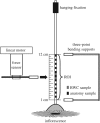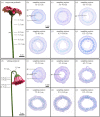Drooping of Gerbera flower heads: mechanical and structural studies of a well-known phenomenon
- PMID: 31551064
- PMCID: PMC6769141
- DOI: 10.1098/rsbl.2019.0254
Drooping of Gerbera flower heads: mechanical and structural studies of a well-known phenomenon
Abstract
Gerbera, one of the most loved cut flowers, is (in)famous for the drooping of its flower heads under dehydration. This effect has been quantified by analysing both fully turgescent and wilting peduncles of Gerbera jamesonii 'Nuance'. Wilting peduncles display pronounced bending in the region directly below the inflorescence after 24 h of dehydration, while the rest of the peduncle remains upright. Using anatomical measurements and three-point bending tests, we have analysed whether this phenomenon is caused by mechanical and/or geometrical alterations. We have found that both the flexural rigidity and the axial second moment of area are significantly decreased in the apical part of wilting peduncles, whereas the bending elastic modulus shows no significant change. Moreover, cross-sections of wilting peduncles ovalize significantly more than those of turgescent peduncles and exhibit considerable shrinkage of the parenchyma, taking up the majority of the cross-sectional area. Generally, the drooping of wilting Gerbera flowers can be regarded as a temporary instability of a rod-shaped cellular solid caused by anatomical differences (tissue arrangement, existence or the absence of a pith cavity) and geometrical changes (the decrease of axial second moment of area, cross-sectional ovalization, shrinkage of tissues) between the apical and basal regions of their peduncles.
Keywords: biomechanics; cross-sectional ovalization; drought stress; flexural rigidity; functional morphology; safety factor.
Conflict of interest statement
We declare we have no competing interests.
Figures


References
-
- Betz O, Birkhold A, Caliaro M, Eggs B, Mader A, Knippers J, Röhrle O, Speck O. 2016. Adaptive stiffness and joint-free kinematics: actively actuated rod-shaped structures in plants and animals and their biomimetic potential in architecture and engineering. In Biomimetic research for architecture and building construction. Biological design and integrative structures (eds Knippers J, Nickel K, Speck T), pp. 135–167. Cham, Switzerland: Springer.
Publication types
MeSH terms
Associated data
LinkOut - more resources
Full Text Sources

